Written by Stefania Zardini Lacedelli and Jane Winters.
In this blog post we aim to help researchers, digital humanities scholars, museum curators, historians to better understand what the digital platform Omeka can do and cannot do – alone or in in combination with other tools – and how it can contribute to the digital curation journey.
In the past decade, the range of digital curation tools available for heritage institutions has increased exponentially. These platforms have been pivotal in extending the access and interaction with digitized cultural resources, and also in providing spaces to experiment with new forms of heritage, engagement and curation. To orientate ourselves in this thriving landscape, we need to adopt a reflective approach towards the digital tools we choose. It is fundamental to understand what their major strengths and potential weaknesses are, in order to unleash their potential without forcing the constraints each tool inevitably has.
The first pilot study of the Congruence Engine project allowed us to develop a shared reflection on Omeka: a free, open source, content management released in 2008 to create online collections and digital archives. This digital tool was originally designed by the Roy Rosenzweig Center for History and New Media to support museums, archives and libraries in their journey towards digital curation. We wanted to explore if Omeka could help the Congruence Engine community not only to link different collections together, but also to enrich the datasets and stimulate new inquiries on the textile industrial history.
During the pilot study, we started an investigation on the affordances of this tool that we have summarized in a list of 10 features. Our reflections draw upon a series of case studies and our personal experience in different research projects. The practical examples described in each section provide a deep insight into the variety of cultural experiences which Omeka has contributed to shape and the similarities of approaches as well as challenges it has introduced.
1. Variety & flexibility
The first feature which impressed us was the versatility of this tool. Omeka has been adopted in a range of institutional contexts – archives, libraries, museums, bottom-up institutions – for a variety of purposes. The Omeka website displays a directory of Omeka-powered projects that can be constantly updated by the users which was, for us, the starting point for our case study analysis. In this online repository, we have grouped a selection of Omeka projects in five main categories: online collections and digital archives, digital interactive exhibits, virtual and digital-born museums, participatory and bottom-up archives and research projects.
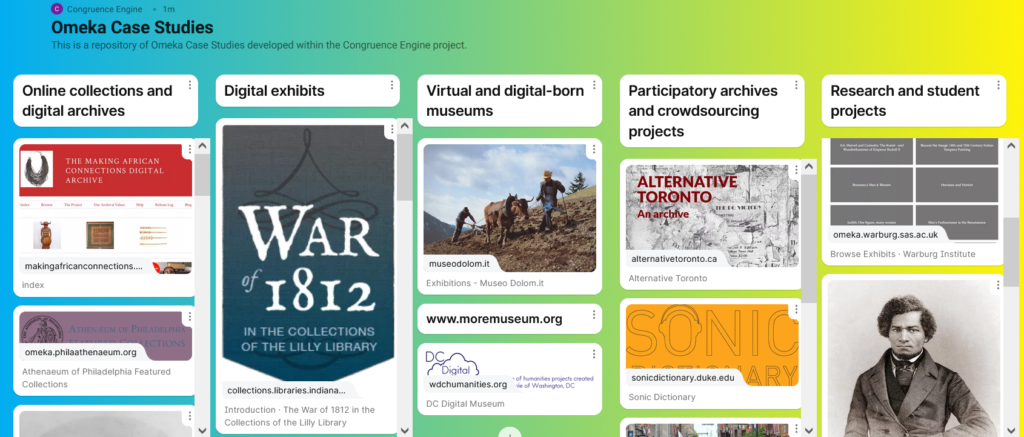
One of the reasons for Omeka’s broad appeal and applicability is that it is both open and (up to a point) free to use. With cost so often the determining factor in technology choices, Omeka can be adopted by organizations with limited resources that want to experiment with digital curation.
2. Combining archival and curatorial functions
Presented as lightweight solution in comparison with traditional repository software (see Saorín, 2011), Omeka has a focus on display. The exhibition-oriented design is revealed by the choice of the name: ‘Omeka’ is a Swahili word which means to display, speak out, or lay out wares. The opportunity to combine the digital object management with the creation of online collections and exhibitions is one of the key reason cultural institutions choose to adopt this tool. This is an emerging need not only for museums, but also for libraries and archives, which want to make their digital resources accessible to online audiences.
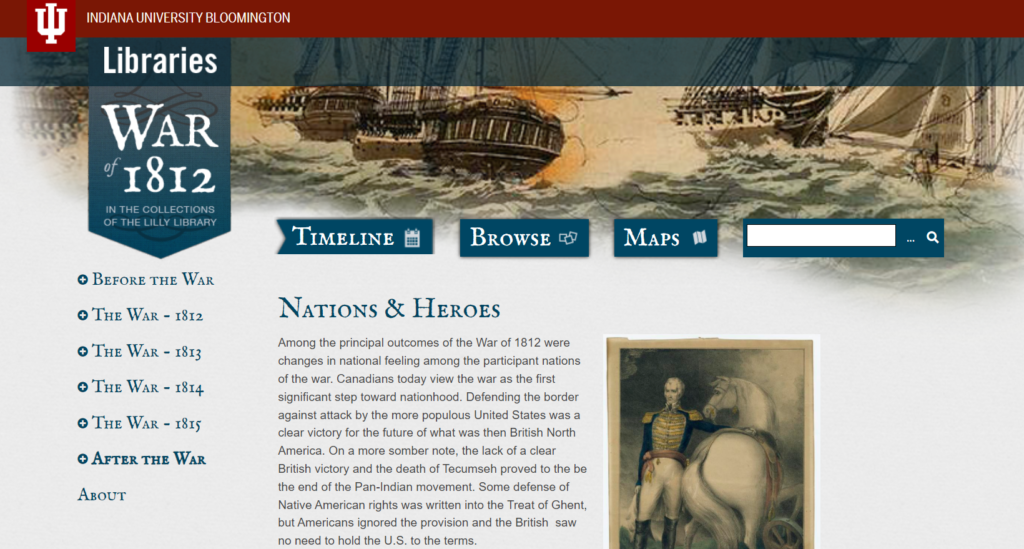
Describing their reasons for choosing Omeka, Jonathan Ainsworth and Maggie Smith from the Saltaire World Heritage Education Association stressed the importance of combining the archival with the curatorial functions, suggesting how Omeka can help to design a virtual museum experience: ‘We don’t want just an online catalogue, we want an online museum. It’s not just about searching and viewing the records, we want to have curated content’ (Teams conversation on 16th March for the Congruence Engine Pilot Study).
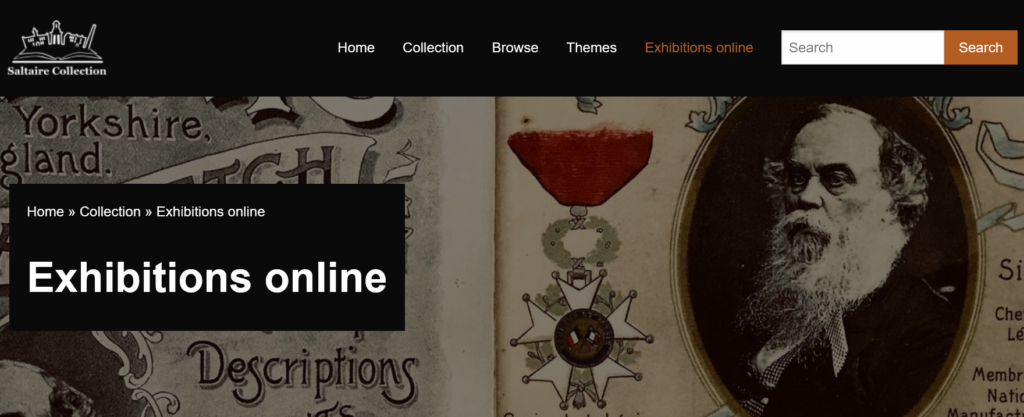
The use of Omeka to support the development of digital-born museum is widespread. One interesting example of this kind of initiative, built on Omeka, is the MoRE Museum, which collects, preserves and exhibits rejected and unrealised art projects from the 20th and 21st centuries. Omeka has allowed these artworks to be given sustainable new life, and helped MoRE to build stories around them.
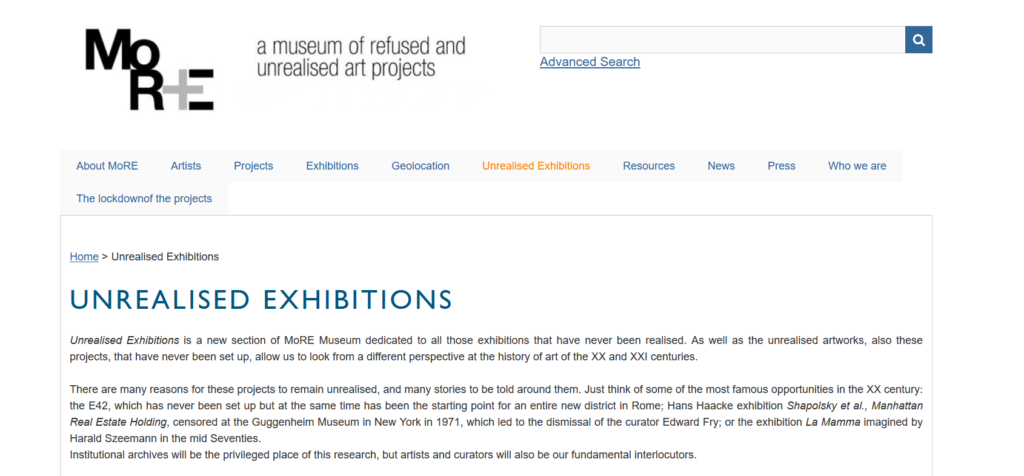
3. Connectivity
Complementary to the exhibit function, specific functionalities in Omeka encourage the creation of connections between different records. ‘Omeka gives you the capability of following a trail through different records, so finding something and then trying to find related resources’ says Jonathan Ainsworth from the Saltaire World Heritage Association. ‘I’ve been experimenting with people records, linking them to each record with which they are associated’.
It is this kind of connectivity, the linking of objects, places, people and communities, which is at the heart of the Congruence Engine and so many other cultural heritage projects. Omeka can help institutions, researchers and practitioners to identify networks, develop pathways through data, and surface unexpected connections. In the ‘Making African Connections’ AHRC funded project, Omeka was used to explore the relationships between the African collections held in Kent and Sussex museums. Up to 600 artefacts were re-catalogued and linked with co-created interpretations, extending the debate over decolonization.
In this kind of project, the collaborative and open nature of the platform fosters the inclusion and foregrounding of diverse voices and interdisciplinary perspectives and can encourage the emergence of new interpretative categories and narratives. This is the case of the Museums of the Dolomites – Laboratory of Stories an Omeka-based space which collects 1200 digital resources from 50 cultural institutions of the Dolomites area (ethnographic and scientific museums, Eco museums, art organizations, local archives, cultural associations, community groups). These items are organized in thematic galleries, each one offering an interdisciplinary perspective on the discovery of the Dolomites heritage. In the Hands in Stone gallery, for example, geologists, anthropologists, and art curators collaborated to provide a multi-dimensional interpretation of the role of the stone in the Dolomites.
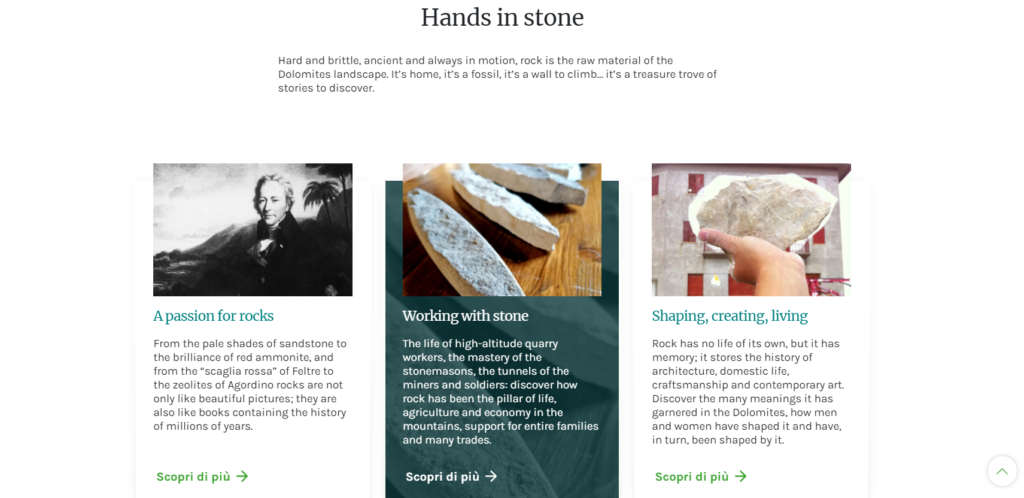
4. Expanding audiences, rethinking languages
Omeka is a great tool for broadening the audiences for heritage projects. The use of a standardized vocabulary (Dublin Core) and tags has often fostered a rethinking of the language, themes and keywords related to cultural items.
The New Roots project, for example, developed a controlled vocabulary of everyday language terms in Spanish and English to improve access for those unfamiliar with Library of Congress subject headings. Multilingual and inclusive metadata and vocabularies are an important means of helping users to find what they are looking for, and even to make them feel that a digital resource reflects them and their experiences (see, for example, Luke, Pezzoni and Russell 2022).
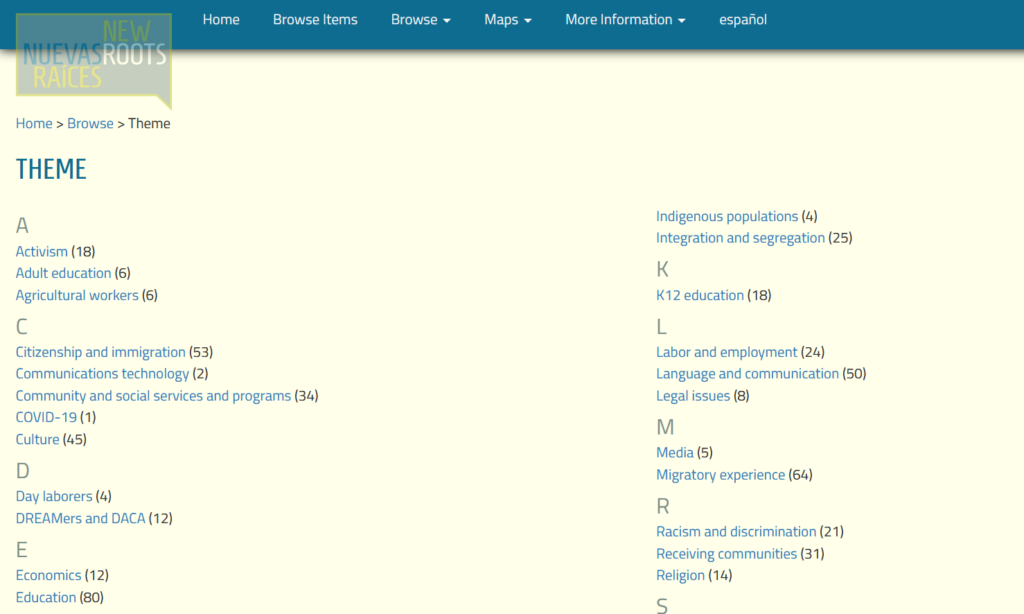
Opening up new forms of access through diversifying metadata is at the heart of a project such as the Metropolitan Museum of Art’s Tagging Initiative, which asked users to add information about what is actually depicted in an artwork (dog, house etc.) rather than more standard cataloguing data about author, type, date etc. This project did not use Omeka, but it demonstrates the benefits of rethinking language and metadata using an online tool of this kind.
5. Enriching & expanding collections
Omeka is a great tool not only for discovery of and access to existing digital collections, but also for the reuse and continuous development of new cultural heritage materials. This type of functionality is supported by a contributor plugin which allows for the direct upload of material – photos, documents, video, reminiscences etc. – to the platform by users.
This is why Omeka websites are often connected with the development of born-digital resources and, in some cases, the creation of new archival material is at the centre of the project. In the Alternative Toronto project, Omeka was used to create a bottom-up archive to document the history of alternative communities in the Greater Toronto Area from 1980 to 1999, and many other grassroots initiatives are born this way.
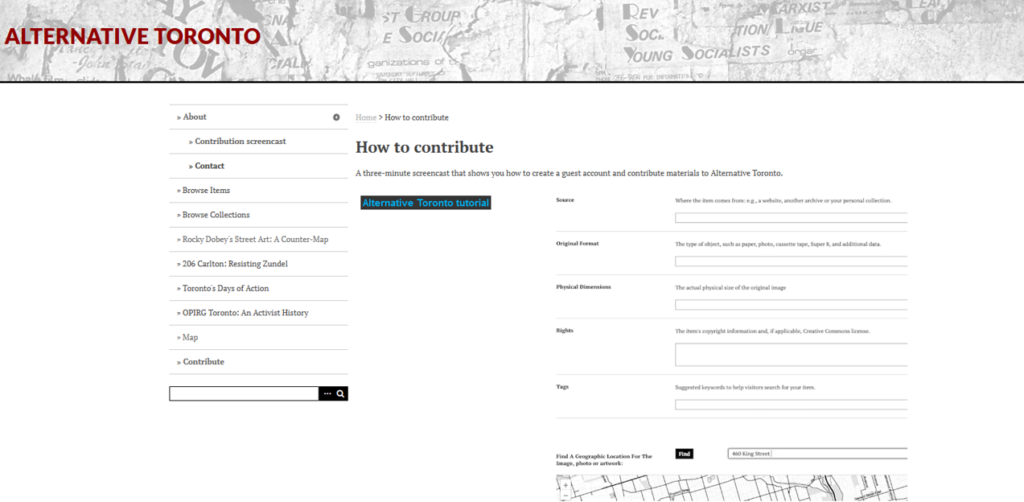
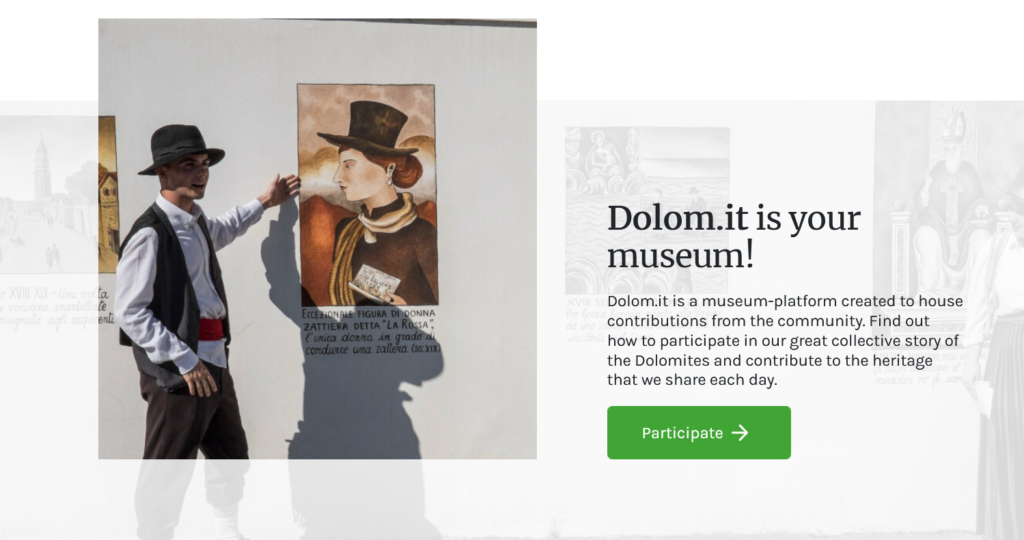
6. Supporting the development of heritage communities
In the projects we have analysed, the boundaries between creators and audiences were often blurred. There are numerous examples of Omeka websites which have been co-created with the communities and groups who also represent the main target audience for the project. The collaborative and co-creation approach is possible because Omeka is easy to use, and active involvement in archive management can be extended to people who do not necessarily have a high level of technical expertise.
This is why very often the websites developed using Omeka are not finished products, but hubs of heritage activities: living and dynamic archives and spaces for collaboration, experimentation and exchange. In both New Roots and Museums of the Dolomites, the Omeka websites supported the development of heritage communities which contribute to the ongoing creation of new memories and stories.

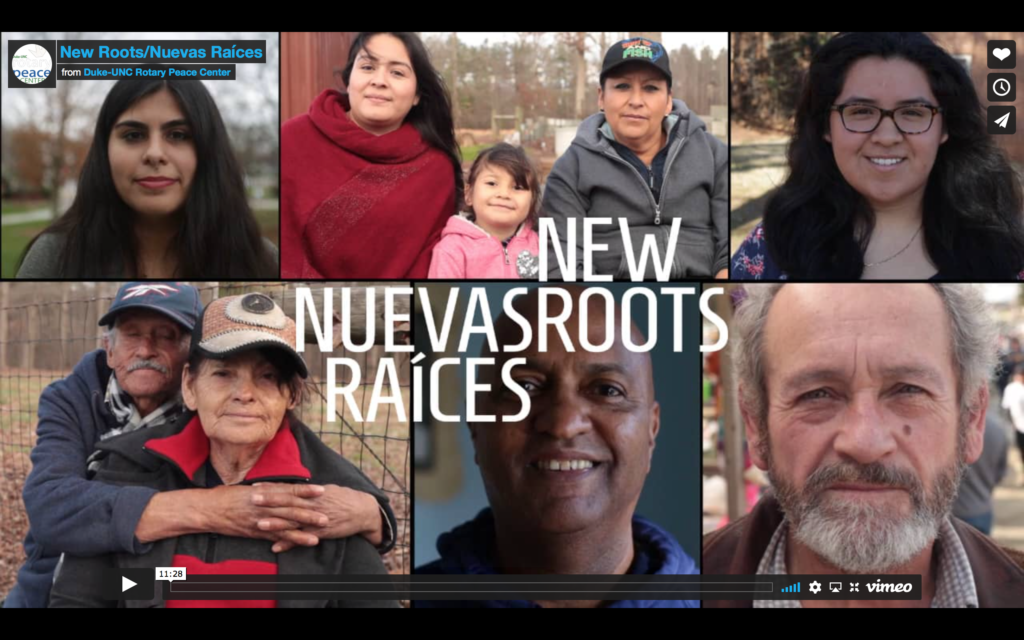
7. Experimental, research and learning space
Omeka is a useful tool for exploring digital humanities topics and experimenting with online collections and digital exhibitions. For example, postgraduate students registered for the MA in Art History, Curatorship and Renaissance Culture at the Warburg Institute in London create online exhibitions using Omeka as part of their course of study. There is an online gallery of student exhibitions, covering such diverse subjects as men’s fashion in the Renaissance and the story of the Old Testament figure Judith as told through art, which illustrates the many different ways in which data can be structured, explored and presented using Omeka.
The Smithsonian’s The Object of History is an online tool with which students can create virtual exhibitions, choosing objects from the collection. Like the Warburg examples, this helps participants to experiment with different kinds of narrative and to explore how to describe objects and structure information.
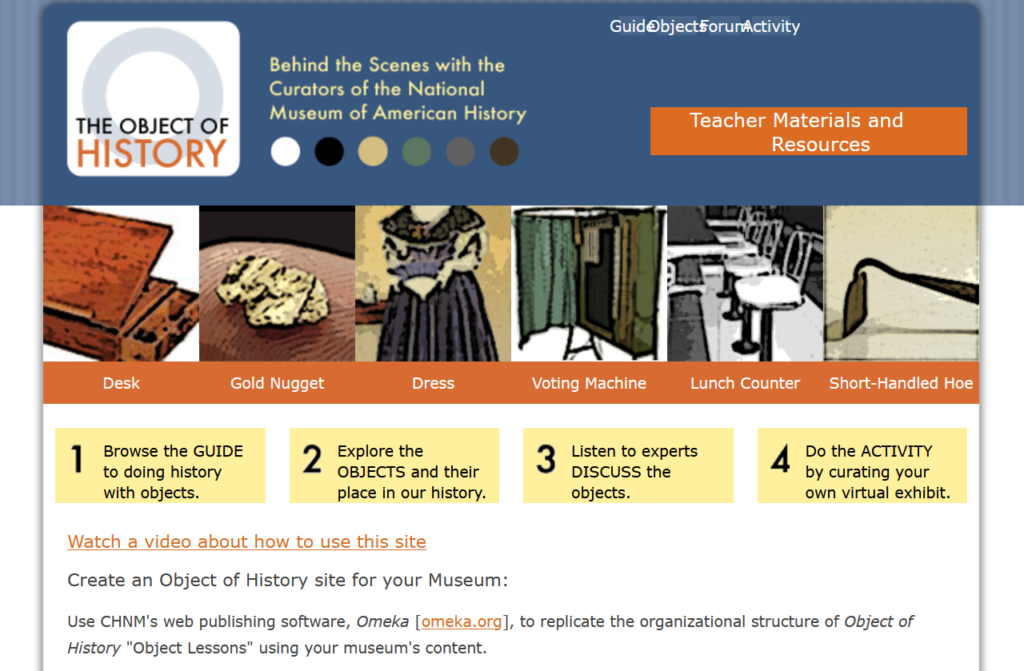
Limitations
But, of course, all tools have their limitations. They are designed to solve certain kinds of problems; they involve compromise between ease of use and sophistication of implementation; they are the result of particular assumptions, interests and skillsets. As we have just shown, Omeka is extremely flexible, easy to use, and ideal for collaborative and interdisciplinary projects, but it does have limitations.
So what, then, is Omeka not so well suited for?
8. Interoperability with other archival systems
Inevitably, Omeka is often used in connection with other datasets and Content Management Systems. Most cultural heritage institutions will have both legacy and active systems in use. The interoperative capabilities of the platform have undoubtedly been enhanced with the launch of the newer version, Omeka S, which has greater export and sharing capabilities, allows the combination of different ontologies/vocabularies, and interacts with Wikidata. But the experience of one of the Congruence Engine pilot projects is that there are significant limitations if you wish to connect different datasets at scale. We hope that a follow-up blog post will discuss these technical challenges in more detail.
9. Metadata standardisation
The main metadata standard used in Omeka is Dublin Core, which is good for standardized different metadata system but is not always the best solution for specific types of items such as bibliographic resources or people records. However, this issue has been addressed by Omeka S which allows the combination of different vocabularies and ontologies. In the Congruence Engine pilot study, we are currently exploring this new opportunity through the creation of a series of Resource Templates, that is a set of pre-defined properties that can be customized for each specific item type.
10. Limitations in terms of interface development
Even though Omeka is an excellent platform for creating online exhibitions, it does not support highly advanced, mobile-optimized, user-friendly interfaces. Both the New Roots and Museums of the Dolomites projects have found the need to develop customized themes for their multilingual sites and more sophisticated interfaces for presenting their material. A key challenge faced by the Museums of the Dolomites project in particular was the difficulty of displaying video and audio content in mobile friendly galleries. This, of course, has resource implications, both human and financial. Although the basic functions are available for free, the platform still requires specialist IT expertise to customise themes and develop new plugins. The community of Omeka developers is growing but is not as sizeable as those which have been built around the most popular content management systems, such as WordPress.
Conclusions
An obvious lesson from working with Omeka, or indeed any digital tool or platform, is that we should not expect it to do everything. It is important to understand what a digital tool can and cannot do, and when to bring in complementary technologies and expertise. Sometimes the specific functionality of a tool opens up new opportunities, but depending on the task, it can equally constrain both what is possible and what is conceivable within a particular project.
The contribution of digital expertise to a project lies not so much in identifying or even creating the perfect, endlessly extensible tool, but rather in thinking about how to combine different tools and approaches to form a robust pipeline. This is not an easy task. There is a huge range of off-the-shelf tools available for heritage institutions, and no one has the time or resource to learn how to use all of them. We hope that by sharing our thoughts about the strengths and weaknesses of one particular tool, Omeka, we will help people wanting to share collections online to identify whether it will work for them – or at least get them part of the way on their digital journey.
References
Gill H., Vos J., Villa-Torres L., Ramirez M.S. (2019). ‘Migrations and Inclusive Transnational Heritage: Digital Innovation and the New Roots Latino Oral History initiative’, The Oral History Review, 46:2, pp.277-299
Hardesty J.L. (2014). ‘Exhibiting Library Collections online: Omeka in context’. New Library World, Emerald Group. Vol. 115 No.3/4, pp. 75-86
Liberman, C.E., Kowaleski, M. (2018). ‘Omeka and Other Digital Platforms for Undergraduate Research Projects on the Middle Ages’ Digital Medievalist 11(1): 3, pp. 1–21
Luke, S.M., Pezzoni, S., Russell, W. (2022). ‘Towards More Equitable, Diverse, and Inclusive Representation in Metadata and Digitization: A Case Study’ The Serials Librarian. DOI: 10.1080/0361526X.2022.2040241
McGregor, J., Baker, J., Stylianou N., et al., The Making African Connections Digital Archive (http://makingafricanconnections.org/, version 1.0, 14 January 2019).
Radovac L. (2018). ‘Re/Mediating the Archive: Building Alternative Toronto’. Continuum, Journal of Media & Cultural Studies. Vol. 32, Issue 1
Rath L. (2016) ‘Omeka.net as a librarian-led digital humanities meeting place’ New Library World, Emerald Group. Vol. 117 No.3/4, pp. 158-172
Saorín T.P. (2011) ‘Eposiciones digitales y reutilización: aplicación del software libre Omeka para la publicación estructurada’. MEI, II, Vol. 2, nr 2.
MoRE. a museum of refused and unrealised art projects. www.moremuseum.org
War of 1812 in the Collections of the Lilly Library, Indiana University Libraries, Indiana University, Bloomington, Indiana at https://collections.libraries.indiana.edu/warof1812/.
Biographies and Twitter handle
Jane Winters is Professor of Digital Humanities at the School of Advanced Study, University of London. She is a Co-Investigator for the Congruence Engine project.
Twitter handle: @jfwinters
Stefania Zardini Lacedelli is Research Fellow at the Science Museum Group. Her research explores new forms of heritage and curatorial practices of the platform world. In her PhD at the University of Leicester, School of Museum Studies she has explored a new conceptualization of the museum as a platform for sound culture. She is involved in the Textile investigation of the Congruence Engine Project, focusing on the role of digital tools in connecting and reimagining heritage collections.
Twitter handle: @StefaniaZLac